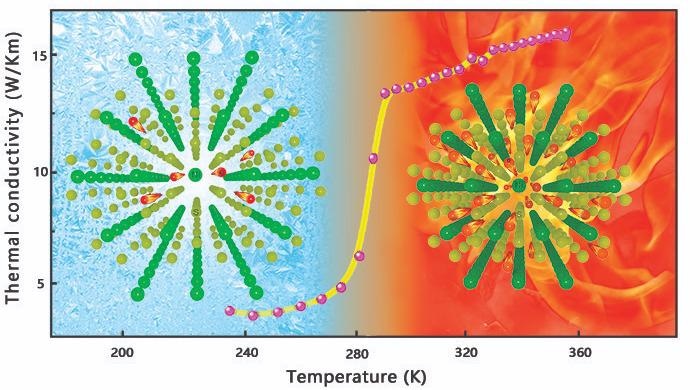Mar 22 2021
Generation or manipulation of heat forms part of nearly 90% of the world’s energy use, and regulating thermal transport is still a challenge in several fields, ranging from nano- and micro-scale electronic devices to aeronautics.
 The abrupt change in thermal conductivity and its mechanism for the hexagonal sulfide Ni1-xFexS. Image Credit: Xuekai Zhang.
The abrupt change in thermal conductivity and its mechanism for the hexagonal sulfide Ni1-xFexS. Image Credit: Xuekai Zhang.
Materials that show a sudden transition between low and high thermal conductance states are highly preferred for fast-developing thermal regulation applications.
A collaborative group of researchers headed by Prof. Peng Tong and Prof. Yongsheng Zhang from the Institute of Solid State Physics (ISSP) of the Hefei Institutes of Physical Science (HFIPS) have described fresh findings of a sharp change in thermal conductivity of up to 200% in sulfides Ni1−xFexS, within a temperature interval of 40 K.
The findings of the study have been reported in a paper published in Acta Materialia.
The observed change of thermal conductivity exceeds those reported in other thermal regulation materials. Moreover, the operation temperature can be well adjusted by tuning the iron concentration, making such a thermal conductivity regulation scheme adaptable to different application needs.
Peng Tong, Professor, Institute of Solid State Physics, Hefei Institutes of Physical Science
“We did theoretical calculations and found that the large jump of thermal conductivity roots from the dramatic modification of the electronic structure at the first-order phase transition,” stated Prof. Zhang, who is a theoretical physicist.
Since the material was brittle by nature, the researchers did something more. They enhanced its machinability and thermal cycling stability by adding silver, which makes it very useful for practical applications.
The huge jump in thermal conductivity together with reversibility indicates that this material is a new potential material for thermal management applications. The hexagonal sulfides can be synthesized easily and the raw materials are environmentally friendly.
This material can be used in a wide range of applications. For example, it can be used to develop thermal diodes. Thermal diodes are analogous to electronic diodes in that they allow heat flow to move only in a particular direction, while blocking it in the opposite direction.
The thermal conductivity of this material can be adjusted autonomously. This enables it to be used to maintain the temperature at an ideal level with respect to variations in the environment temperature.
This research was financially supported by the National Natural Science Foundation of China, the Key Research Program of Frontier Sciences, and the Users with Excellence Program of Hefei Science Center of the Chinese Academy of Sciences.
Journal Reference:
Zhang, Z. K., et al. (2021) High-contrast, reversible change of thermal conductivity in hexagonal nickel-iron sulfides. Acta Materialia. doi.org/10.1016/j.actamat.2021.116709.